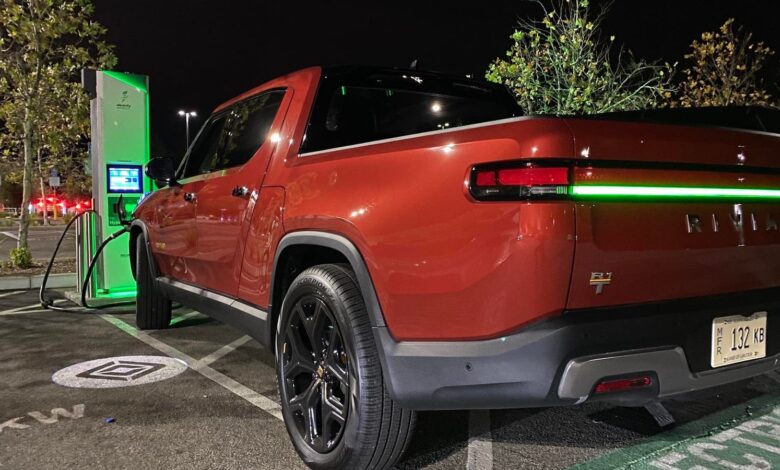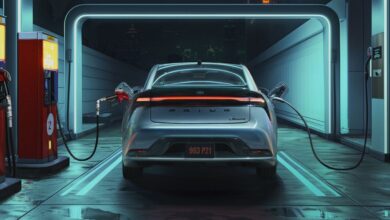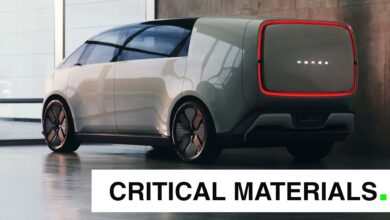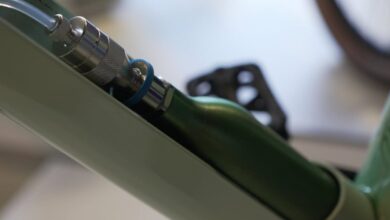Still ‘Plug And Pray’ At Electrify America Chargers In Summer 2024

Charging a Rivian R1T next to a Hummer EV (it’s a tight fit) at an Electrify America charging … [+]
Public EV fast charging falls into two camps: Tesla and everyone else. The first generally works, the other too often doesn’t. One is plug and play, the other often isn’t.
Electrify America is a big part of the everyone else. Especially when it comes to public Level 3 charging, aka, fast charging. Yes, charging at Electrify America can be flawless sometimes. Some days it just works. On those days public charging can actually be gratifying. But too often it’s frustrating. What follows is not hyperbole or gratuitous criticism. Just a depiction of my experience at EA. I’ve included a response from Electrify America and commentary from an analyst below also.
“Get in line, brother”: That’s the the watchword at most Electrify America charging stations at most times in Los Angeles where I live. The lines happen almost invariably because of lack of chargers and/or broken chargers. And usually a combination of those two. I could give a litany of examples. (I have been using Electrify America ever since it installed charging stations near me in Los Angeles in early 2020.) For brevity’s sake, I’ll give one (below) — the most recent.
Recent experience at Electrify America — dodgy chargers, angry patrons: This is just one experience out of many similar experiences. This month (May) I went to an EA station in Valencia, California, which is part of Santa Clarita, a Los Angeles suburb. When I got there, two out of the six chargers were down apparently. I say apparently because I didn’t actually try the chargers. But two cars were already waiting ahead of me and nobody was using those two chargers. Based on my experience, if people are waiting and not using chargers, those chargers almost certainly are not working. So, I decided to try my luck at another Electrify America location in Stevenson Ranch, also part of Santa Clarita Valley. Here, one out of four was down. And the other three were being used. Problem was, there was no indication that the faulty charger wasn’t working. (It didn’t indicate “Not Available” or have a blank screen or show any other sign that it wasn’t working.) I tried it. Then got in line after I determined it was not working. And I counted five customers that tried the charger (and failed). I tried to warn some people but eventually you give up because new people keep arriving and you can’t stop them from trying too. This pattern happens all the time at EA chargers (if there’s no obvious indication the charger isn’t working). People obviously are frustrated/confused because they expect the charger to work. Some people got in line, others drove off in frustration. Next problem: the guy on charger #3 was a new user and having trouble with the EA app. So, he was stuck trying to get the app to work. I tried to help him as did others. But he basically monopolized that charger for an eternity (once he got his app working) because he didn’t know enough about EVs to stop at 80 percent. He wanted a 100 percent charge — which takes an eternity because charging slows to a crawl in the last 20 percent of a charge. Nevertheless, I finally got started on a charge at another charger. And then more people began to arrive and the line got longer. Soon there were four people waiting. Then, as I was leaving, a second charger crashed. Screen went blank. Guy who was using it, said “forget it…it’s not working now” to the next customer. When I left, there were three people waiting and only two chargers working.
Upshot — two hours to get a charge: It took me about 2 hours to get a charge (including avoiding Valencia). And I talked to several frustrated EA customers. They feel helpless (as I do) because there’s nobody on site to talk to (like there is at a gas station). And people generally don’t call support. Some people do but many don’t. And I talked to an EV newbie who was angry and said he wished he had a Prius plug-in hybrid so he could avoid public chargers. Upshot: lots of anger and frustration.
Input from Electrify America: Windows Vs Mac? “Since our founding, Electrify America has focused on building an inclusive and open hyper-fast charging network to help facilitate the adoption of electric vehicles (EVs),” Anthony Lampkin, vice president of operations at Electrify America, told me in email. He has a point. EA has to accommodate many different vehicle brands with different specifications. You could say it’s Windows (EA) vs Mac (Tesla). That may be part of reason for the plug-and-pray mindset of customers.
High growth means “tremendous stress test” …old chargers a problem: “In 2023, the network grew to over 900 stations and 4,000 chargers across 47 U.S. states, the District of Columbia, and six Canadian provinces,” Lampkin said. “Additionally, in 2023, Electrify America doubled the number of customer charging sessions and energy dispensed over 2022. The company delivered more than 10 million customer sessions and approximately 380 gigawatt hours (GWh) of energy. With such high growth, our network has undergone a tremendous stress test. Some of our chargers are 5 years old and getting replacement parts is getting harder as more of them age, or worse, as vandalism (cutting cables for the copper) is increasing and taking away available replacement parts,” Lampkin said.
Next-gen chargers: Lampkin continued. “The primary focus of the station upgrades is to modernize legacy equipment to the newest generation of chargers, improving the customer experience, and making public fast charging a more seamless process,” he said. “We are focusing on replacing low-performing chargers with our newest chargers, which were purposely built to withstand heavier usage. In the last two years, we replaced over 680 chargers, and this year, we are aiming to accelerate replacements to an additional 800+,” according to Lampkin.
Proactive Electrify America programs: Lampkin says EA is expanding its team of in-house engineers who are responsible for quality and preventative maintenance. And this includes “regular inspection of chargers to ensure a quality experience for customers.” And a “newly expanded warehouse and distribution capabilities improve time for parts and inventory levels.”
Industry “failed to grasp significance of Tesla’s supercharging system” — Conrad Layson, analyst at AutoForecast Solutions: “The legacy multinational OEMs failed to grasp the significance of Tesla’s supercharging system,” Conrad Layson, Senior Analyst, Alternative Propulsion, AutoForecast Solutions, told me. “Tesla made sure to install their chargers in visible and easily accessible locations. But the secret to their success came in how the Tesla-designed EVSE interacted with the Tesla EVs, for a truly ‘plug and play’ experience,” Layson said, referring to Electric Vehicle Supply Equipment.
No interconnectivity on non-Tesla chargers: “Up to now [the non-Tesla world] have all been using EVSE with no interconnectivity,” said Layson. “That is, the EVSE do not report back to the home office. So, [a charging operator may list] the station as available, but hasn’t a clue how many chargers are actually in operation at any one time. When [an operator] learns of a downed charger, they contract maintenance out to a third party. But the…operators don’t have maintenance technicians on staff. The whole experience is frustrating,” according to Layson.
Tesla Supercharger advantage: Other chargers not truly plug and play: “None of the other EVSE currently on the market are truly plug and play, like Tesla,” Layson said. “The Tesla charger and EV have an electronic exchange of data at the start of the charging session, something that all the other charging systems don’t currently do,” according to Layson. “Tesla chargers tell the EVs what kind of charging cable is installed (i.e. liquid cooled), the charger’s maximum throughput, and other data. The charger learns from the EV the battery’s state of charge, state of health, temperature, and other pertinent data. Only after all parameters are learned, does Tesla’s charger send the optimal current to the EV, and modulates it throughout the charging session. The result is that if you preconditioned your battery prior to the charging session, you stand a greater likelihood of charging [at a high rate],” according to Layson.
My take: Like Tesla, EV manufacturers need to get involved directly in public charging in a big way. Why? One charging system works (Tesla’s) one often doesn’t (everyone else) — Tesla’s recent Supercharger unit restructuring notwithstanding. Tesla took direct responsibility for its chargers, the others didn’t. In the end, the EV driving experience is only as good as the public charging network. You can drive the fastest, coolest EV around but if you get stuck at a charging station for two hours that just doesn’t seem to matter much anymore.



